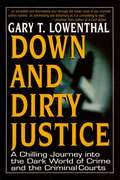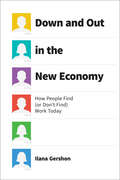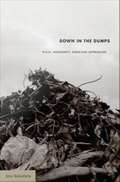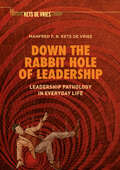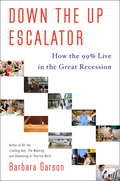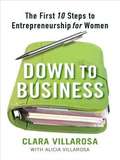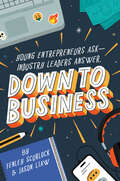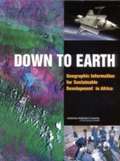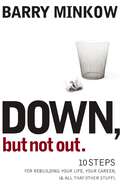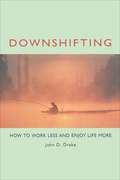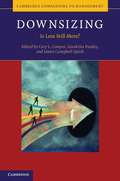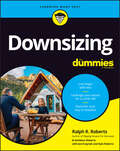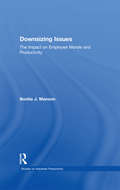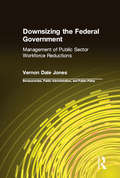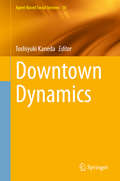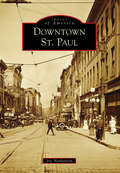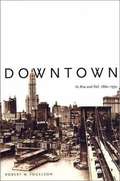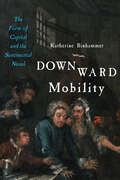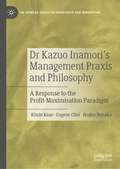- Table View
- List View
Down and Dirty Justice
by Gary T. LowenthalWhen Professor of Law Gary T. Lowenthal takes a sabbatical and descends from the ivory towers of academia, he finds himself in a very different system of criminal justice than the one her trains his students to expect. Working in the trenches at the county attorney's office, he becomes entangled in a provocative kidnapping trial, one that takes him deep into a dark and disturbing world of criminals, victims, attorneys and judges, where innocence isn't always the best defense.
Down and Out in the New Economy: How People Find (or Don’t Find) Work Today
by Ilana GershonFinding a job used to be simple. You’d show up at an office and ask for an application. A friend would mention a job in their department. Or you’d see an ad in a newspaper and send in your cover letter. Maybe you’d call the company a week later to check in, but the basic approach was easy. And once you got a job, you would stay—often for decades. Now . . . well, it’s complicated. If you want to have a shot at a good job, you need to have a robust profile on LinkdIn. And an enticing personal brand. Or something like that—contemporary how-to books tend to offer contradictory advice. But they agree on one thing: in today’s economy, you can’t just be an employee looking to get hired—you have to market yourself as a business, one that can help another business achieve its goals. That’s a radical transformation in how we think about work and employment, says Ilana Gershon. And with Down and Out in the New Economy, she digs deep into that change and what it means, not just for job seekers, but for businesses and our very culture. In telling her story, Gershon covers all parts of the employment spectrum: she interviews hiring managers about how they assess candidates; attends personal branding seminars; talks with managers at companies around the United States to suss out regional differences—like how Silicon Valley firms look askance at the lengthier employment tenures of applicants from the Midwest. And she finds that not everything has changed: though the technological trappings may be glitzier, in a lot of cases, who you know remains more important than what you know. Throughout, Gershon keeps her eye on bigger questions, interested not in what lessons job-seekers can take—though there are plenty of those here—but on what it means to consider yourself a business. What does that blurring of personal and vocational lives do to our sense of our selves, the economy, our communities? Though it’s often dressed up in the language of liberation, is this approach actually disempowering workers at the expense of corporations? Rich in the voices of people deeply involved with all parts of the employment process, Down and Out in the New Economy offers a snapshot of the quest for work today—and a pointed analysis of its larger meaning.
Down in the Dumps: Place, Modernity, American Depression
by Jani ScanduraMucking around in the messy terrain of American trash, Jani Scandura tells the story of the United States during the Great Depression through evocative and photo-rich portraits of four locales: Reno, Key West, Harlem, and Hollywood. In investigating these Depression-era "dumps," places that she claims contained and reclaimed the cultural, ideological, and material refuse of modern America, Scandura introduces the concept of "depressive modernity," an enduring affective component of American culture that exposes itself at those moments when the foundational myths of America and progressive modernity--capitalism, democracy, individualism, secularism, utopian aspiration--are thrown into question. Depressive modernity is modernity at a standstill. Such a modernity is not stagnant or fixed, nor immobile, but is constituted by an instantaneous unstaging of desire, territory, language, and memory that reveals itself in the shimmering of place. An interpretive bricolage that draws on an unlikely archive of 1930s detritus--office memos, scribbled manuscripts, scrapbooks, ruined photographs, newspaper clippings, glass eyes, incinerated stage sets, pulp novels, and junk washed ashore--Down in the Dumps escorts its readers through Reno's divorce factory of the 1930s, where couples from across the United States came to quickly dissolve matrimonial bonds; Key West's multilingual salvage economy and its status as the island that became the center of an ideological tug-of-war between the American New Deal government and a politically fraught Caribbean; post-Renaissance Harlem, in the process of memorializing, remembering, grieving, and rewriting a modernity that had already passed; and Studio-era Hollywood, Nathanael West's "dump of dreams," in which the introduction of sound in film and shifts in art direction began to transform how Americans understood place-making and even being itself. A coda on Alcatraz and the Pentagon brings the book into the present, exploring how American Depression comes to bear on post-9/11 America.
Down the Rabbit Hole of Leadership: Leadership Pathology in Everyday Life
by Manfred F. Kets de VriesIn the previous book in this series, Manfred Kets de Vries observed the experiences of leaders on a rollercoaster ride through their professional and personal lives. Now, he follows them down the rabbit hole into the unknown, where, like Lewis Carroll’s Alice, they find a dystopian Wonderland in which everyone seems to have gone mad and life functions according to its own crazy logic, throwing up all kinds of obstacles in the search for truth.Understanding what is happening around us has become more difficult than ever in the Age of Trump. Don’t imperatives like “build that wall” sound very much like “Off with his head”? Unfortunately, and unlike Alice, we are not going to wake up from a bad dream and discover that everything is “nothing but a pack of cards”.The first part of this book looks at the psychodynamics of leadership in both a business and a political context. The second focuses on the psychopathology of everyday life in organizations and the seemingly endless ways people can make a mess of things – including mega pay packages, acting out, digital addiction and other dysfunctional behaviour patterns. Each chapter ends with a brief anecdote to illustrate the dilemma it presents.In short, sharp nuggets, Kets de Vries helps make sense of how the madness of the present has affected leadership in organizations and the workplace.
Down the Up Escalator
by Barbara GarsonOne of our most incisive and committed journalists--author of the classic All the Livelong Day--shows us the real human cost of our economic follies. The Great Recession has thrown huge economic challenges at almost all Americans save the super-affluent few, and we are only now beginning to reckon up the human toll it is taking. Down the Up Escalator is an urgent dispatch from the front lines of our vast collective struggle to keep our heads above water and maybe even--someday--get ahead. Garson has interviewed an economically and geographically wide variety of Americans to show the painful waste in all this loss and insecurity, and describe how individuals are coping. Her broader historical focus, though, is on the causes and consequences of the long stagnation of wages and how it has resulted in an increasingly desperate reliance on credit and a series of ever-larger bubbles--stocks, technology, real estate. This is no way to run an economy, or a democracy. From the members of the Pink Slip Club in New York, to a California home health-care aide on the eve of eviction, to a subprime mortgage broker who still thinks it could have worked, Down the Up Escalator presents a sobering picture of what happens to a society when it becomes economically organized to benefit only the very rich and the quick-buck speculators. But it also demonstrates the wit and resilience of ordinary Americans--and why they deserve so much better than the hand they've been dealt.
Down to Business
by Clara VillarosaA bulletproof, step-by-step plan for turning your business brainstorm into a money-making reality At age fifty-two , after years of working her way up the corporate ladder, Clara Villarosa found herself out of a job. But she didn't let that get her down. Instead, she put her gifts to the test and started her own business, which became one of the country's best-known independent specialty bookstores-The Hue- Man Bookstore. Now, twenty years and two successful stores later, Clara is a highly sought-after business coach and expert in the industry. Down to Business expands on Villarosa's proven "First 10 Steps to Entrepreneurship for Women" to offer women everywhere a targeted plan to help them launch the small business of their dreams. This book includes advice on: ?How to develop realistic business ideas by researching the industry ?Analyzing a competitor's marketing approach and attracting your ideal customer ? Accumulating the start-up funds you need, from recruiting investors to using loans wisely ?Scouting the ideal location ? Creating a sound business plan-and beyond-with a simple, step-by-step strategy Packed with stories of businesswomen at all stages of the game-from a beer connoisseur-turned-brewer to an avid reader-turned-literary agent-Villarosa brings together inspiring, real-life stories with her award-winning business savvy. Encouraging and empowering, Down to Business will get you motivated to dust off your dream and get your plan into action.
Down to Business: 51 Industry Leaders Share Practical Advice on How to Become a Young Entrepreneur
by Fenley Scurlock Jason LiawYou have a start-up idea but ... where do you go from there? Two teen entrepreneurs bring together 51 influential business leaders for Q&As about starting a business, finding success, and, yes, making money.Fifteen-year-olds Fenley Scurlock and Jason Liaw had both started businesses by the time they'd reached middle school. In this groundbreaking book, these young entrepreneurs interview leaders involved with brand-name businesses like MasterClass, Hallmark, IKEA, Parachute, and more.They ask questions every burgeoning exec wants to know: How can I get started? Is college worth it? What skills do I need? How did YOU make it big?In a book that's unlike any book out there--for kid or adult entrepreneurs--Fenley and Jason give readers access to leading innovators, inventors, and executives as they tell their stories and provide tips to a new generation of bosses.
Down to Earth: Geographic Information for Sustainable Development in Africa
by Committee on the Geographic Foundation for Agenda 21In 1992, world leaders adopted Agenda 21, the work program of the 1992 U. N. Conference on Environment and Development. This landmark event provided a political foundation and action items to facilitate the global transition toward sustainable development. The international community marked the tenth anniversary of this conference in Johannesburg, South Africa, in August 2002. "Down to Earth, a component of the U. S. State Department's "Geographic Information for Sustainable Development" project for the World Summit, focuses on sub-Saharan Africa with examples drawn from case-study regions where the U. S. Agency for International Development and other agencies have broad experience. Although African countries are the geographic focus of the study, the report has broader applicability. "Down to Earth summarizes the importance and applicability of geographic data for sustainable development and draws on experiences in African countries to examine how future sources and applications of geographic data could provide reliable support to decision-makers as they work towards sustainable development. The committee emphasizes the potential of new technologies, such as satellite remote-sensing systems and geographic information systems, that have revolutionized data collection and analysis during the last decade.
Down, But Not Out: 10 Steps for Rebuilding Your Life, Your Career, (and all that other stuff)
by Barry MinkowEveryone's had a bad day, some of us have had a lot worse. But as Barry Minkow shows in this inspirational and empowering book, you can come back from anything. He started from jail-and millions in debt. You might be starting from a wrecked marriage. Or a business gone belly up. Whatever your failure, you can overcome and get beyond it starting today. In Down, But Not Out, Barry explains the 10 all-important steps you need to succeed in the process. You may not end up helping the FBI bust investment fraud like Barry does today, but you can turn your life around and get back on the road to success. Barry shows you how.
Downhill from Here: Retirement Insecurity in the Age of Inequality
by Katherine S. NewmanA sharp examination of the looming financial catastrophe of retirement in America.As millions of Baby Boomers reach their golden years, the state of retirement in America is little short of a disaster. Nearly half the households with people aged 55 and older have no retirement savings at all. The real estate crash wiped out much of the home equity that millions were counting on to support their retirement. And the typical Social Security check covers less than 40% of pre-retirement wages—a number projected to drop to under 28% within two decades. Old-age poverty, a problem we thought was solved by the New Deal, is poised for a resurgence.With dramatic statistics and vivid portraits, acclaimed sociologist Katherine S. Newman shows that the American retirement crisis touches us all, cutting across class lines and generational divides. White-collar managers have seen retirement benefits vanish; Teamsters have had their pensions cut in half; bankrupt cities like Detroit have walked away from their commitments to municipal workers. And for Generation X, the prospects are even worse: a fifth of them expect to never be able to retire. Only the vaunted “one percent” can face retirement without fear.Other countries are confronting similar demographic challenges, yet they have not abandoned their social contract with seniors. Downhill From Here makes it clear that America, too, can—and must—do better.
Downshifting: How to Work Less and Enjoy Life More
by John D DrakeWho has never wished to step off the ever-accelerating treadmill of work, just to gain some kind of balance in life? Downshifting is a practical, hands-on guide that actually shows how to move from the fast track to a more satisfying, healthier, less work-focused lifestyle. John Drake, himself a former high-level executive who chose to downshift, details a wide range of realistic, doable alternatives to a work-dominated life. He guides readers through all they need to know and do to make a good living, yet find more free time for themselves and those they care most about. Organized by level of risk-from such low-risk steps as simply changing work style to bold actions, such as flextime, lateral or downward moves, and shortened work weeks-this book is the first to really show how to put specific downshifting options into action. Using real-life stories of people who have successfully downshifted, Drake reveals how to get past the wistful dreaming and hand-wringing stages to taking decisive, thoughtful steps for implementing real change in your work-life. Step by step, the author walks the potential downshifter through all the stages of preparation, from examining personal fears and psychological readiness for change to analyzing the impact on loved ones and personal finances. And for those ready to initiate downshifting changes, he provides practical strategies and specific guidelines for selling downshifting plans to the organization, including vital information for determining the approach, timing, and presentation of a downshift proposal. Should the organization reject your downshifting plan, Drake shows how to leave bridges unburned, regroup, and wisely assess your alternatives. For readers just beginning to contemplate a work-life change or those eager to downshift, Downshifting provides the guidance, tools, encouragement, and proof needed to create a more balanced, relaxed, and fulfilling life.
Downsizing
by Cary L. Cooper Alankrita Pandey James Campbell QuickDownsizing is one of the most frequently used business strategies for reducing costs, returning firms to profit or for restructuring businesses following takeovers, mergers and acquisitions. Downsizing measures are also set to become much more prevalent in the public sector as governments seek to restrict levels of public spending. This book is one of the first to provide a thorough study of downsizing from a global perspective. It examines the phenomenon in its entirety, exploring how it is initiated and what the process of downsizing looks like. It also looks at the effects of downsizing at a number of different levels, from the individual (e. g. , motivational effects, effects on health and stress levels) to the organizational (e. g. , financial outcomes, reputational and productivity outcomes). Written by an international team of experts, the book provides a comprehensive overview of downsizing that examines both the strategic and human implications of this process.
Downsizing For Dummies
by Ralph R. Roberts Joseph Kraynak Kyle Roberts Kathleen RobertsOrganize, declutter, donate—downsize and simplify your life Downsizing For Dummies provides you with strategies to downsize your life by moving to a smaller home, decluttering, simplifying your budget, and saving more money. You&’ll find tips to help decrease your cost of living, lower your home maintenance costs, protect and leverage your assets, and decide whether downsizing is right for you and your family. After downsizing your life, you&’ll save time on household chores and gain the freedom and flexibility that come with having fewer possessions. What will you do with all the time you save? Downsizing For Dummies will help you understand the benefits of living simply! Discover ways to declutter and simplify every corner of your life Weight the pros and cons of moving to a smaller home Save time and money by cutting down on your chores and home maintenance Experience a reduced stress level when you create space at home and workThis book is for anyone who is ready to live clutter-free and to downsize. It&’s the perfect Dummies guide for homeowners looking to save money, plus real estate brokers who are working with clients who are downsizing, and designers and builders of new homes who want to stay on top of the downsizing trend.
Downsizing Issues: The Impact on Employee Morale and Productivity (Studies on Industrial Productivity: Selected Works)
by Bonita J. MansonFirst Published in 2001. Routledge is an imprint of Taylor & Francis, an informa company.
Downsizing the Federal Government: Management of Public Sector Workforce Reductions
by Vernon D JonesThe main focus of downsizing has shifted from the private to the public sector. The cutbacks began in the Department of Defense. Now the goal is a federal civilian workforce reduction of 12 percent by the year 2000.This pioneering study looks at the management of workforce reductions in the public sector both in theory and in practice. Three case studies -- of the Defense Logistics Agency, the Bureau of Reclamation, and the Food and Drug Administration -- illustrate the organizational, managerial, and human dimensions of attempting to improve performance with reduced resources. The author draws on extensive interviews with senior executives and middle managers in the three agencies; at the General Accounting Office, the Office of Personnel Management, and the National Performance Review; the Senior Executives Association and the Federal Managers Association; and scholars and researchers.In a larger sense, this work pushes the boundaries of knowledge concerning organizational change and makes a significant contribution to organization theory. It offers important new insights not only for public sector managers but for organization theorists and management specialists whose work on downsizing has been presumed but not shown to be applicable to the public sector.
Downtown Dynamics (Agent-Based Social Systems #16)
by Toshiyuki KanedaIn urban analytics, ‘crowding’ implies the spatiotemporal distributional unevenness of people’s stays and flows in middle-scale urban spaces, and has since become an emerging keyword, attracting not only practical interests but also research interests, especially in the current IoT devised downtown. This book presents a collection of papers on a series of exploratory studies on the rise and fall of downtowns (Downtown Dynamics), which the author’s group has been working on with the aim of constructing an artificial society that contributes to the planning and management of crowds by developing Agent-Based Social Simulation (ABSS). In particular, the book includes (1) an analysis of 20 years’ worth of survey data on visitors’ shopping-around behavior for Osu district in Nagoya city, as a representative Japanese downtown, (2) correlation analyses of spatial distributions between Visibility Graph Analysis (VGA) as a “visibility index” and crowding in middle scale urban spaces, (3) agent modeling of visitors’ shopping-around behavior and construction of the Downtown Dynamics Model as an artificial society, and (4) modeling of the vision-driven agent as a “crowd generator” and its applicability to spatial design and sign layout in urban spaces. The book also includes a novel research program derived from complexity system science that provides new approaches to Agent-Based Modeling (ABM), social simulation, regional sciences, geo-informatics, and urban planning studies for researchers and graduate students, as well as planning scientists and practitioners such as town managers and planners who are concerned with downtown revitalization.
Downtown Ladies: Informal Commercial Importers, a Haitian Anthropologist and Self-Making in Jamaica
by Gina A. UlysseThe Caribbean "market woman" is ingrained in the popular imagination as the archetype of black womanhood in countries throughout the region. Challenging this stereotype and other outdated images of black women, Downtown Ladies offers a more complex picture by documenting the history of independent international traders--known as informal commercial importers, or ICIs--who travel abroad to import and export a vast array of consumer goods sold in the public markets of Kingston, Jamaica. Both by-products of and participants in globalization, ICIs operate on multiple levels and, since their emergence in the 1970s, have made significant contributions to the regional, national, and global economies. Gina Ulysse carefully explores how ICIs, determined to be self-employed, struggle with government regulation and other social tensions to negotiate their autonomy. Informing this story of self-fashioning with reflections on her own experience as a young Haitian anthropologist, Ulysse combines the study of political economy with the study of individual and collective identity to reveal the uneven consequences of disrupting traditional class, color, and gender codes in individual societies and around the world.
Downtown St. Paul (Images of America)
by Iric NathansonMinnesota's capital city was given a lofty identity when young Catholic priest Lucien Gaultier built a modest log chapel in a wilderness clearing and named it for his patron saint. St. Paul's modern downtown would later take shape at this very site. In the mid-19th century, St. Paul's strategic location at the head of navigation on the Mississippi River was naturally suited as a way station for goods and a hub for settlers pouring into the Upper Midwest. While St. Paul had to relinquish its ranking as Minnesota's largest city to its twin, Minneapolis, the city remains at the center of state politics as Minnesota's state capital. Following World War II, a suburban boom weakened the business district, and downtown St. Paul fell into decline. Over the last 40 years, however, St. Paul's downtown has been reinvented as a major sports, entertainment, and cultural center.
Downtown: Its Rise and Fall, 1880-1950
by Robert M. FogelsonDowntown is the first history of what was once viewed as the heart of the American city. Urban historian Robert Fogelson gives a riveting account of how downtown--and the way Americans thought about it--changed between 1880 and 1950. Recreating battles over subways and skyscrapers, the introduction of elevated highways and parking bans, and other controversies, this book provides a new and often starling perspective on downtown's rise and fall.
Downward Mobility: The Form of Capital and the Sentimental Novel
by Katherine BinhammerHow do the stories we tell about money shape our economies?Beginning in the late eighteenth century, as constant growth became the economic norm throughout Europe, fictional stories involving money were overwhelmingly about loss. Novel after novel tells the tale of bankruptcy and financial failure, of people losing everything and ending up in debtor's prison, of inheritances lost and daughters left orphaned and poor. In Downward Mobility, Katherine Binhammer argues that these stories of ruin are not simple tales about the losers of capitalism but narratives that help manage speculation of capital's inevitable collapse.Bringing together contemporary critical finance studies with eighteenth-century literary history, Binhammer demonstrates the centrality of the myth of downward mobility to the cultural history of capitalism—and to the emergence of the novel in Britain. Deftly weaving economic history and formal analysis, Binhammer reveals how capitalism requires the novel's complex techniques to render infinite economic growth imaginable. She also explains why the novel's signature formal developments owe their narrative dynamics to the contradictions within capital's form. Combining new archival research on the history of debt with original readings of sentimental novels, including Frances Burney's Cecilia and Camilla, Sarah Fielding's David Simple, and Oliver Goldsmith's The Vicar of Wakefield, Downward Mobility registers the value of literary narrative in interpreting the complex sequences behind financial capitalism, especially the belief in infinite growth that has led to current environmental crises. An audacious epilogue arms humanists with the argument that, in order to save the planet from unsustainable growth, we need to read more novels.
Dr Kazuo Inamori’s Management Praxis and Philosophy: A Response to the Profit-Maximisation Paradigm (The Nonaka Series on Knowledge and Innovation)
by Ikujiro Nonaka Kimio Kase Eugene ChoiThis book offers a meditation on the links between philosophy and its implementation, interpreting why and how a leader's "philosophy" strengthens his action predicated on the purposeful vision of life; and discusses the a hypothesis that performance control in management may be driven by transcendental and intrinsic motivations, contrasting with the traditional management control theory. It construes how Inamori's management philosophy disciplines accounting and finance management towards putting its basic tenets into practice. Examining, in particular, the history of Kyocera, the authors provide a contemplative look at a human centric philosophy, which will be of interest to scholars of management, corporate executives, and economists with a philosophical bent.
Dr. Benjamin Hooks and Children's Health Forum
by Rosabeth Moss Kanter Charles J. Ogletree Jr. Aldo Sesia Howard Koh Carmel Salhi Abbye Atkinson"Dr. Benjamin Hooks and Children's Health Forum" charts the many different career paths of Hooks, a civil right activist and pioneer. Hooks' positions ranged from lawyer, judge, preacher, entrepreneur to the first African American commissioner of the Federal Communications Commission (FCC) and to the head of the National Association for the Advancement of Colored People (NAACP) to the co-founder of the non-profit Children's Health Forum (CHF). CHF's mission was to eradicate lead poisoning in children in the United States. The case provides an overview of lead poisoning in the U.S., including how it is measured, its causes, and legislation enacted to prevent it. The case asks students to reflect on Hooks' leadership choices and his decision to launch CHF. How would they assess Hooks as a leader? What made him a strong leader? Given Hooks' past experiences, do they think that Hooks made the right decision to focus on lead poisoning after leaving the NAACP? Is this an area where he could have the most impact?
Dr. Ing. h.c. F. Porsche AG (A): True to Brand?
by Carin-Isabel Knoop Jeffrey FearExamines one of the most important entrepreneurial decisions made in the history of Porsche, made in early 1998: to build a sport utility vehicle (SUV)--the Cayenne. After decades of relying on one or two sports car models and nearly going bankrupt and losing its independence in 1993, Porsche had to diversify its product lines. Also examines the branding implications of the internationalization of production.
Dr. Ing. h.c. F. Porsche AG (B): Made in Germany
by Carin-Isabel Knoop Jeffrey FearAn abstract is not available for this product.
Dr. John's Products Ltd.
by William A. SahlmanDescribes an entrepreneur's attempts to invent, manufacture, and distribute an inexpensive electric toothbrush.
